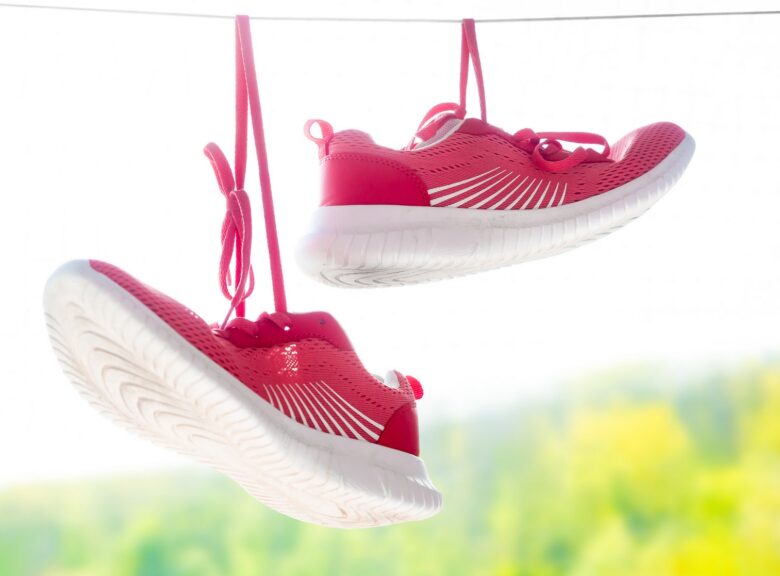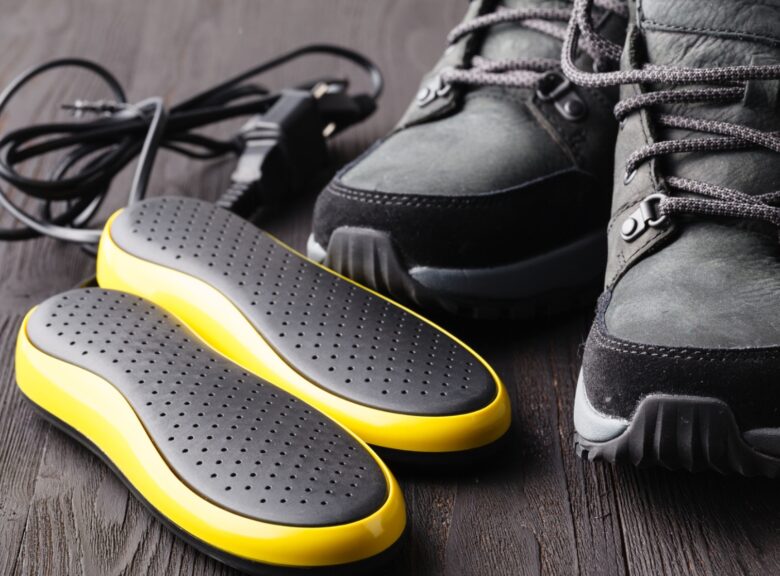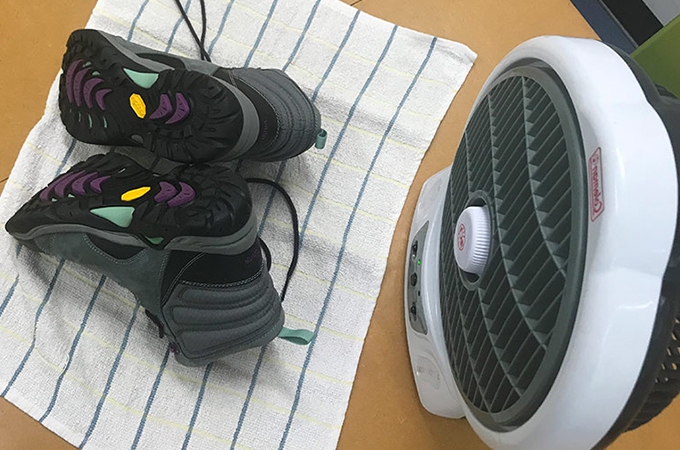Keeping your shoes clean and dry is an important part of shoe care. Whether you’ve been caught in the rain during a run or your shoes simply need cleaning, it’s crucial to properly dry them afterward. Drying shoes improperly can cause issues for both your feet and the shoes.
Certain materials used in shoe construction aren’t meant to withstand high heat. However, failing to dry shoes thoroughly can lead to problems like blisters or mold growth. Choosing drying methods suited for athletic footwear is essential to protect your shoes and feet.
In this article, we will explore why thorough drying is necessary after shoes get wet.

Source: canva.com
Contents
Importance of Drying Your Shoes
It’s common for runners to face wet shoes, whether from rain, streams, or other water exposure during runs. However, failing to dry damp shoes properly can lead to issues.
Running in soggy shoes feels uncomfortable and allows bacteria to grow. Wetness may contribute to blisters or fungal infections like athlete’s foot if shoes aren’t dried out thoroughly. Wet materials inside shoes are also at risk of mold or damage over time.
Of course, occasional wet runs are inevitable and shouldn’t be avoided. But after wet runs or races, prioritizing shoe dryness is important. Leaving shoes damp encourages deterioration and health problems for feet.
The best approach is to dry running shoes after they become wet fully. Using effective drying techniques helps shoes maintain odor control, support, and a longer lifespan. Driers shoes mean feet stay healthier and happier for future runs. With proper drying care, runners can comfortably handle wet conditions without lasting shoe or foot impacts.
How to Dry Your Running Shoes Like a Pro
Use Newspaper
Newspaper is an inexpensive and effective option for drying wet running shoes. While newspapers may not be as ubiquitous now, they remain readily available at stores and absorb well.
If shoes are heavily soaked, consider lightly brushing the outer surfaces first to remove any dirt or debris that could slow drying.
Be sure to remove insoles, as they will air dry separately. Loosen laces and open up shoes as much as possible. Crumple several pages of newspaper and stuff them inside each shoe. For very wet shoes, place them in a well-ventilated area wrapped in a towel to contain moisture. Towels are not needed for slightly damp shoes.
Check the shoes and newspaper periodically, replacing the newspaper if it becomes too saturated before the shoes are dry. Newspaper drying may take up to 12 hours for thorough results, so patience is required. The paper wicks water away, while airflow aids evaporation from shoe materials. This natural process quickly and cheaply dries footwear using readily available materials.

Source: canva.com
Invest in Boot Dryers
According to Alpine Dryers, keeping your boots dry is essential but challenging after wet weather. Boot dryers are a convenient solution that speeds up the drying process. Some models use gentle heat, while others rely on airflow circulation like a fan. Both approaches help evaporate moisture faster than allowing boots to air dry unattended.
Many quality boot dryer options are on the market today. For casual drying needs, a basic model may suffice. However, if you demand maximum performance, premium dryers such as 230V Alpine Boot Dryers deliver top-tier drying power and dependability.
Consider adding a boot dryer to your mudroom or entryway for convenience. After outdoor activities in wet conditions, simply place your boots on the dryer.
The steady air circulation will quickly evaporate lingering water, ensuring your footwear is ready for its next outing. A boot dryer eliminates the wait time of air drying alone. It’s a simple investment that pays off in keeping boots drier between wears.
Dry Shoes With a Fan
When shoes get wet, a fan can help speed up the drying process. The moving air circulates like a breeze, preventing moisture from staying trapped inside closed shoes.
To set up a fan-drying system, gather a few supplies. Bend wire coat hangers into U-shapes to use as supports. Remove laces and insoles from wet shoes to allow better airflow. Place shoes with U-shaped hangers on either side so they hang directly in front of a running box fan.
Repeat the process for the other shoe. Be sure laces are secured away from the fan blades to avoid accidents. The circulating air will quickly evaporate water from all surfaces of the shoes.
Insoles and laces can also dry near the fan setup using clothespins. Let the fan run for a few hours until the shoes feel completely dry. Check periodically to flip or rotate for even drying.
Once dry, return the insoles to the shoes and lace them back up. The forced air method eliminates waiting time compared to passive air drying. With a little MacGyver-ing of coat hangers, a standard fan speeds the process of getting footwear dry and ready to wear again quickly.

Source: vessi.com
Dry and Deodorize Shoes With Rice
Rather than letting wet shoes sit and potentially develop odors, put unused rice to work absorbing moisture. All it takes is a container and some patience.
Begin by finding a lidded box large enough to accommodate your shoes with space between them and the lid. Fill the bottom with plain white rice, leaving room at the top.
Place the damp shoes directly on the rice bed and seal the container. The rice’s natural properties will pull water away from the shoes over the next few hours.
Check periodically to see if your shoes feel completely dry. The rice granules soak up lingering dampness efficiently.
Beyond rapid drying, the rice also helps eliminate odors from sweat or other moisture. Your shoes will be fresh-smelling as well as dry when you reopen the container.
Repurposing extra rice in this simple homemade setup is an effective way to get shoes wear-ready again without using power or special equipment.
There are various methods runners can use to ensure their shoes dry completely after getting wet. It’s important that moisture is fully removed to prevent health issues for the feet, like blisters or infections.
Leaving shoes damp can also damage certain materials over time. The article highlighted low-cost solutions like using newspapers to absorb water while air dries the shoes. A fan provides circulating airflow to speed up the drying process.
Boot dryers are more convenient for quickly drying shoes with heated air. Even rice serves as a homemade desiccant that pulls moisture away from shoes. Whichever approach is chosen, it is essential that wet shoes are thoroughly dried after runs or activities to keep feet happy and shoes in top condition for future use. Proper drying avoids lingering dampness issues.
